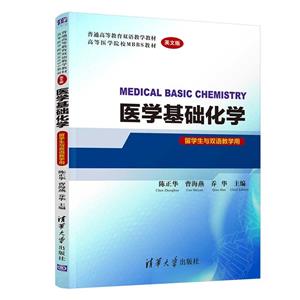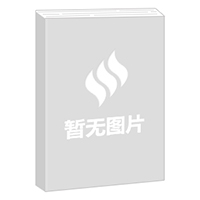醫學基礎化學 MEDICAL BASIC CHEMISTRY(英文版)(留學生與雙語教學用) 版權信息
- ISBN:9787302577850
- 條形碼:9787302577850 ; 978-7-302-57785-0
- 裝幀:70g膠版紙
- 冊數:暫無
- 重量:暫無
- 所屬分類:>>
醫學基礎化學 MEDICAL BASIC CHEMISTRY(英文版)(留學生與雙語教學用) 本書特色
適讀人群 :留學生與雙語教學用醫用基礎化學是一門公共基礎課,主要介紹與醫學有關的化學知識。學習該課程有利于后續課程的學習,能為學生將來的醫學研究和臨床工作打下堅實的基礎。根據醫學生的專業特點、需求,結合留學生的語言特點和自身學識基礎,由淺入深系統的介紹化學基礎知識。講述化學在醫學研究和臨床中的應用,彌補其它教材的不足。采用PBL(以問題為中心)的方法編寫教材。
醫學基礎化學 MEDICAL BASIC CHEMISTRY(英文版)(留學生與雙語教學用) 內容簡介
醫學基礎化學是為了適應醫學各專業的特點和需要而開設的一門基礎課程。《醫學基礎化學(英文版)(留學生與雙語教學用)》是專為來華醫學留學生編寫的全英文教材,也適用于普通高等院校雙語教學使用。 《醫學基礎化學(英文版)(留學生與雙語教學用)》內容包括無機化學、分析化學和物理化學中與醫學衛生領域相關的基本理論和基礎知識,重點突出醫學知識、信息和化學理論的密切聯系,在確保化學知識詳盡介紹的同時,為化學和醫學建立起一座橋梁,不僅有利于后續課程的學習,也能為學生將來從事臨床醫學和研究T作奠定堅實的基礎。
醫學基礎化學 MEDICAL BASIC CHEMISTRY(英文版)(留學生與雙語教學用) 目錄
目錄
Chapter 1 Introduction.............................................. 1
1.1 Chemistry is a Central Science ........................... 1
1.2 The Scope of the Book ......................................... 1
1.3 Advice for Studying Chemistry ......................... 2
Chapter 2 Colligative Properties of Dilute Solutions ..................................................... 3
2.1 Concentration Expressions .............................................3
2.2 Lowering of Vapor Pressure and RAOULT'S Law.................................................... 4
2.3 Boiling Point Elevation........................................ 6
2.4 Freezing Point Depression ............................................7
2.5 Osmotic Pressure.................................................. 8 Exercises ....................................................................... 12
Chapter 3 Acid-Base Dissociation Equilibria ... 13
3.1 Br?nsted-Lowry Theory of Acids and Bases.....13
3.2 The Autoionization of Water and the pH Scale ........................................................ 15
3.3 Ionization Constants for Weak Acids and Bases..................................................................... 16
3.4 Calculating the pH of Solutions of Weak Acids and Bases ............................................................. 20 Problems....................................................................... 25
Chapter 4 Buffer Solutions .................................... 26
4.1 Composition and Action of Buffer solutions..... 26
4.2 The pH Value of Buffer Solutions.................... 27
4.3 Buffer Capacity and Buffer Range...................29
4.4 Preparation of Buffer Solutions........................ 30
4.5 Buffer Solutions in Human Blood.................... 32 Problems....................................................................... 33
Chapter 5 Acid-Base Titration............................. 35
Introduction ........................................................ 35
5.1
5.2 Acid-Base Indicators.......................................... 35
5.3 The Titration Curve and the Selection of Indicators............................................................. 37
5.4 Standard Solutions of Acids and Bases........... 41
5.5 Application of Acid-Base Titration.................. 43 Problems....................................................................... 44
Chapter 6 Thermodynamics.................................. 45
6.1 The First Law of Thermodynamics.................. 45
6.2 Thermochemistry ............................................... 48
6.3 The Second Law of Thermodynamics............. 52
6.4 Molar Gibbs Free Energy of Reaction ............. 54 Problems....................................................................... 57
Chapter 7 Chemical Kinetics................................ 59
7.1 The Rate of a Chemical Reaction ..................... 59
7.2 The Theory of Chemical Kinetics..................... 60
7.3 Effect of Concentration on Rates of Reactions.............................................................. 61
7.4 Effect of Temperature on Reaction Rates........ 65 Problems....................................................................... 66
Chapter 8 Chemical Equilibrium ....................... 67
8.1 The Concept of Equilibrium ............................. 67
8.2 Equilibrium Constants ...................................... 67
8.3 Calculating Values of Equilibrium Constants... 68
8.4 Application of Equilibrium Constants............ 68 Problems....................................................................... 69
Chapter 9 Electrochemistry................................... 70
9.1 Oxidation-Reduction Reactions ....................... 70
9.2 Voltaic Cells ........................................................ 71
9.3 Electrode Potentials and Cell Potentials ......... 73
9.4 The Uses of Electrode Potentials...................... 77 Problems....................................................................... 79
_x00C_Chapter 10 Atomic Structure and Periodicity... 81
10.1 The Atomic Spectrum of Hydrogen and the Bohr Theory................................................81
10.2 The Properties of Microscopic Particles........ 82
10.3 The Structure of Hydrogen Atom.................. 83
10.4 Many-Electron Atoms ..................................... 88
The Periodic Table............................................ 91 Problems....................................................................... 93
10.5
Chapter 11 Covalent Bond and Intermolecular Forces ........................................................ 95
11.1 Covalent Bond and the Valence Bond Theory................................................................ 95
11.2 Hybrid Orbital Theory .................................... 98
11.3 Molecular Orbital Theory ............................. 101
Delocalized π Bond ........................................ 104
11.4
11.5 Intermolecular Forces and Hydrogen Bonding............................................................ 105 Problems..................................................................... 107
Chapter 12 Coordination Compounds........... 109
12.1 Introduction to Coord ination Compounds... 109
12.2 Bonding Theory of Coordination Compounds..................................................... 112
12.3 Coordination Equilibria ................................ 114
Chelate ............................................................. 117
12.4
Problems..................................................................... 118
Chapter 13 Colloids................................................. 119
13.1 Colloidal Disperse System ............................ 119
13.2 The Properties of Sol...................................... 119
Problems..................................................................... 124
Keys to Exercises .......................................................... 125
Appendix A Standard Thermodynamic Data for Selected Substances at 298.15 K ... 131 Appendix B Standard Molar Enthalpies of Combustion for Selected Substances at 298.15 K................ 133 Appendix C Cumulative Stability Constants of Coordination Compounds
(298.15 K)........................................... 134 References ........................................................................ 140
展開全部
醫學基礎化學 MEDICAL BASIC CHEMISTRY(英文版)(留學生與雙語教學用) 作者簡介
主編陳正華:畢業于南開大學化學系,碩士學位,副教授,是天津醫科大學第一批授予留學生教學資格的教師。1995年至今在天津醫科大學從事醫用化學本科生、留學生教學。從事留學生英文授課17年。主持國家“十五”重點立項課題“21世紀中國高等學校農林/醫藥類專業數理化基礎課程的創新與實踐”子項目 ,醫學化學(基礎化學、有機化學融為一體)新課程體系的創新與研究”,主持天津醫科大學教學研究基金“醫用基礎化學雙語教學課程建設”,參與衛生部課題---視聽教材醫用化學綜合性實驗。主編供留學生使用的教材《GENERAL CHEMISTRY》,《Guid to Chemical Experiments》,《Experimental Organic Chemistry Fo rMedical Students》,校內出版。主持編寫教育部全英文臨床醫學專業《基礎化學英語教學大綱》。參編教育科學“十五”國家規劃課題研究成果《醫用化學實驗》 高等教育出版社,《基礎化學習題解析》 高等教育出版社, 《醫用基礎化學實驗》 科學普及出版社。















